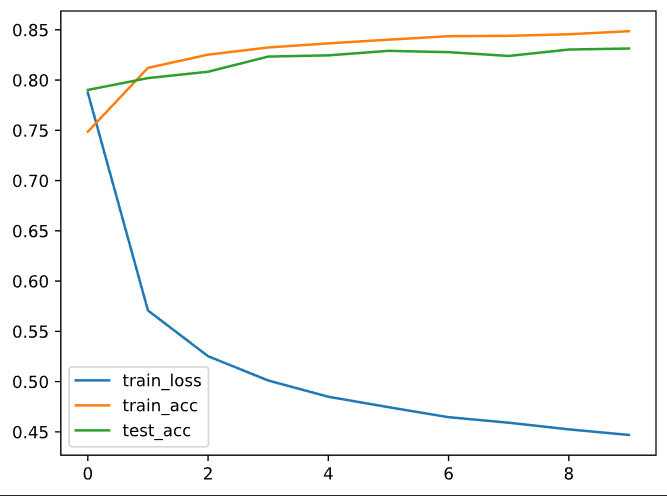下载数据集
下载“fashion_mnist”数据集,进行分类
1
2
3
4
5
6
7
8
9
10
11
12
13
14
15
16
17
18
19
20
21
| import torchvision
from torch.utils import data
from torchvision import transforms
def load_data_fashion_mnist(batch_size, resize=None):
"""下载Fashion-MNIST数据集,然后将其加载到内存中"""
trans = [transforms.ToTensor()]
if resize:
trans.insert(0, transforms.Resize(resize))
trans = transforms.Compose(trans)
mnist_train = torchvision.datasets.FashionMNIST(
root="./data", train=True, transform=trans, download=True)
mnist_test = torchvision.datasets.FashionMNIST(
root="./data", train=False, transform=trans, download=True)
return (data.DataLoader(mnist_train, batch_size, shuffle=True,
num_workers=workers),
data.DataLoader(mnist_test, batch_size, shuffle=False,
num_workers=workers))
batch_size = 256
train_iter, test_iter = load_data_fashion_mnist(batch_size)
|
相关工具函数
1
2
3
4
5
6
7
8
9
10
11
12
13
14
15
16
17
|
def accuracy(y_hat, y):
"""计算预测正确的数量"""
if len(y_hat.shape) > 1 and y_hat.shape[1] > 1:
y_hat = y_hat.argmax(axis=1)
cmp = y_hat.type(y.dtype) == y
return float(cmp.type(y.dtype).sum())
def evaluate_accuracy(net, data_iter):
"""计算在指定数据集上模型的精度"""
if isinstance(net, torch.nn.Module):
net.eval()
metric = np.array([0,0])
with torch.no_grad():
for X, y in data_iter:
metric += [accuracy(net(X), y), y.numel()]
return metric[0] / metric[1]
|
构建全连接层神经网络
1
2
3
4
5
6
7
8
9
10
11
12
13
14
15
16
17
18
19
20
21
22
23
24
25
| num_inputs = 784
num_outputs = 10
num_epochs = 10
net = nn.Sequential(
nn.Flatten(),
nn.Linear(784, 256),
nn.ReLU(),
nn.Linear(256, 10)
)
def init_weights(m):
"""如果是全连接层,初始化参数为标准正态分布"""
if type(m) == nn.Linear:
nn.init.normal_(m.weight, std=0.01)
net.apply(init_weights)
lr, num_epochs = 0.1, 10
loss = nn.CrossEntropyLoss(reduction='none')
optimzer = torch.optim.SGD(net.parameters(), lr=lr)
|
1
2
3
4
5
6
7
8
9
10
11
12
13
14
15
16
17
18
19
20
21
22
|
data_ls = []
for epoch in trange(num_epochs):
metric = np.array([0, 0, 0])
for X, y in train_iter:
y_hat = net(X)
l = loss(y_hat, y)
optimzer.zero_grad()
l.mean().backward()
optimzer.step()
metric += [float(l.sum()), accuracy(y_hat, y), y.numel()]
train_loss, train_acc = metric[0] / metric[2], metric[1] / metric[2]
test_acc = evaluate_accuracy(net, test_iter)
data_ls.append((test_acc, train_loss, train_acc))
fig, ax = plt.subplots(1, 1)
ax.plot(list(range(len(data_ls))), [i[1] for i in data_ls], label="train_loss")
ax.plot(list(range(len(data_ls))), [i[2] for i in data_ls], label="train_acc")
ax.plot(list(range(len(data_ls))), [i[0] for i in data_ls], label="test_acc")
ax.legend()
|




